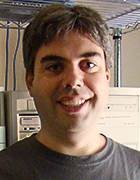Fujitsu exec says SAS may take years to hit your array
Fujitsu's product development VP talks about the development of SAS, why Fujitsu won't be competing with Hitachi's 1 TB drive and the Star-Trek-like future of disks.
Joel Hagberg: It's really broken up into segments -- Fujitsu today takes part in the 2.5-inch mobile, as well as enterprise server segment. Mobile has shifted to SATA over last couple of years, but there still seems to be significant opportunity for growth with the 2.5-inch form factor, since the shift from desktops to notebooks continues to happen. In the last two years we've also seen Microsoft and Sony Corp. both move to 2.5-inch gaming devices. More consumer companies are shipping desktops with 2.5-inch drives, because the acoustics, shock [tolerance], vibration, power draw and heat dissipation is much better than with 3.5-inch drives.
|
||||
Hagberg: [The] 3.5-inch drives have a bigger actuator -- it's noisy and it's built to go in a tower case on the floor, not for the mobile environment.
What about the enterprise space?
Hagberg: SAS is going to take over anything that still used UltraSCSI 320. From an external-storage standpoint, Fibre Channel vendors don't see really any new requirement to shift away from current devices, since it already replaced 320 a long time ago and SATA is also an alternative.
In the high-end SAN market, Fibre Channel will retain its position for at least the next couple of years. Maybe in 2009 or 2010, at the next product refresh, these vendors will start thinking about a shift to small form factor or entertain putting SAS into some offerings.
As long as you can get a higher capacity Fibre Channel and SATA drive than the current limit of 147 GB with small form factor, that piece of the market will stay with 3.5-inch designs. But if you see 300 GB SAS drives a couple years from now, they might be able to create interesting designs with very densely packed drives -- there are people out there with drawing boards thinking about it.
What other disk-drive technologies are on the horizon?
Hagberg: Fujitsu has been able to create the smallest spot on a head writing to media to get us to the terabyte recording level. It's below 100 nanometers -- roughly 80 by 60. With thermal-assist [perpendicular] recording we were able to write to less than a 100-nanometer spot.
We've also announced the first 300 GB, 2.5-inch drive geared for the consumer market, primarily the Asian household. Three hundred gigabytes will allow an all-in-one entertainment device for the Japanese household where you can surf the Internet, do homework, things like that, but then fold the display down if guests come over and you don't want to be distracted by the Internet or television. Several other consumer electronics companies are interested in this technology.
Does recording at the terabyte level mean you'll release a competitor to Hitachi's 1 TB drive?
Hagberg: No -- by terabyte level, we mean a terabit per square inch. That drive they have -- I haven't seen the exact specs, but it's probably 200 GB on a platter in a 3.5-inch desktop drive, which equates to 150 GB per square inch. That's less than one-fifth of what's required for a terabit per square inch. That's a couple of generations out. Meanwhile, Fujitsu will continue to focus on small form factor; the largest 2.5-inch drive today is 300 GB, and we make that.
Also, with a drive the size of Hitachi's in a desktop model, for enterprise servers you have to restrict the I/Os so you can get to the "enterprise" duty cycle of 100%. You have to put in throttling software to slow down the flow of data if it's hit too aggressively. That will allow [Hitachi] to call it "enterprise" because you can leave it on 24/7, but it won't get to that 100% duty cycle without slow motion mode.
This touches on another issue with disk drives today -- drive capacity keeps going up, but the speed of access technologies isn't increasing proportionately. How is Fujitsu working to address this?
Hagberg: Going to a small form factor in densely packed systems could give you 100 heads moving, reading and writing in a very small amount of time in a very small enclosure. The more spindles and the more heads, the more quickly data can be transferred. There are also a lot of ideas on the market in terms of what could or couldn't be used as far as hybrid, solid-state drives, which can deliver silicon performance in a tiered architecture using regular drives for archival and nearline storage purposes, and at the other end, including a high-performance caching system.
Is this what the Hybrid Storage Alliance between you and the other manufacturers is all about?
Hagberg: Fujitsu is a member of that group, but it's really about single-user boot up issues on notebooks, how to improve boot time -- it doesn't mean it'll help a server environment with a bunch of drives.
Now we're back to the drawing board again.
Hagberg: Well, Fujitsu is looking at those technologies and ways to pull data faster, but nothing is publicly announced. One of the things about the disk drive industry is that no matter what you're working on in your labs, you have to cross-license stuff with competitors -- long-term success depends on who the second and third sources are coming to market with. Great new technology doesn't mean it's going to be a slam dunk.
Hypothetically speaking then … the disk drive has been around for just over 50 years now. What do you think it will look like in another 50?
Hagberg: There have been predictions the disk drive will die. So many technologies are thrown out every year as the "disk-drive killer," like flash. Over time, Moore's Law will get to the point where it can solve flash writeability issues. Long-term, static, solid-state disk drives may evolve. Fifty years from now there'll probably be some pretty interesting memory technology. Some of the labs at MIT and other places are growing artificial brain technologies and those could take over somewhere down the line. In the meantime, there may also be other materials out there with a much higher aerial density than the ones we use now -- there's a lot of work with holographic drives, and crystal substrates that may make the next generation's disk like the magic "dilithium" crystals in Star Trek. [Laughs].









